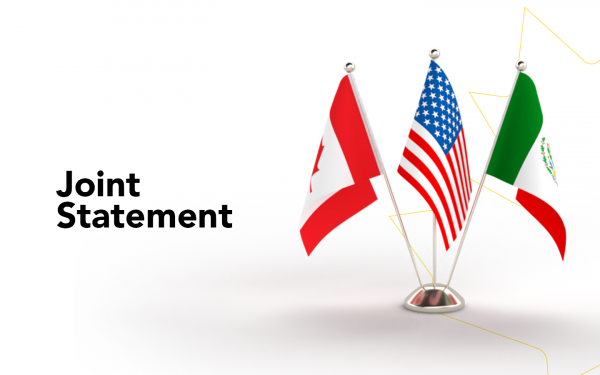Rethinking an oil and gas cap
Letter to The Honourable Steven Guilbeault, P.C., M.P., Minister of Environment and Climate Change in regards to the plan of introducing an emissions cap in the oil and gas sector.
Dear Minister,
Members of the Business Council of Canada (BCC) urge you to rethink your government’s plan to introduce an emissions cap in the oil and gas sector. Pursuing a sector-specific emissions policy would come at a high cost, further eroding the basis of Canada’s carbon regime and creating undue harm to the economy and the purchasing power of Canadians. There are other measures your government can and should be pursuing that would have a far greater impact on lowering emissions.
The BCC and its members support the objective of reducing emissions to net zero by 2050. We have also long supported carbon pricing as an essential tool in the climate toolbox. Likewise, we see an essential role for fair, responsive, and efficient regulation to build public trust as we develop new infrastructure to support Canada’s energy transition. With a projected investment of $2 trillion required to transition towards a net zero economy, we need a policy framework that is clearly set up to drive capital deployment at speed and scale. As per our recommendations made to you earlier this year, such a policy framework is necessary to incent the scale of investment in technology required to reduce emissions in the oil and gas industry and in accordance with Canada’s climate change goals.
The proposed emissions cap for the country’s oil and gas sector is the wrong policy tool for the following reasons:
- It undermines the federal government’s national carbon pricing regime
As part of the Pan-Canadian Framework for Clean Growth and Climate Change, governments and businesses agreed that carbon pricing would be the foundation for reducing emissions in the years to come. The rationale was straightforward: by placing a broad economy-wide price on carbon emissions, Canada would be on a path to achieve its climate goals while supporting competitive and sustainable businesses in their transition to a low carbon economy. Creating sector-specific pricing regimes was never part of the initial construct and it would be ill-advised for the federal government to move in this direction. A well-designed carbon tax plays no favourites. The goal is to reduce emissions, not to shut down a particular sector.
As noted by Chris Ragan, Paul Rochon and Mark Jaccard, reducing emissions at the lowest possible cost to consumers is central to Canada’s carbon pricing regime. Consistent broad-based and uniform incentives allow companies and individuals to identify with confidence the best options for reducing emissions. Carbon pricing currently applies to 82 per cent of all emissions produced in Canada.
As argued by Trevor Tombe, a cap on oil and gas emissions moves us away from the basic principles of having a national, broad-based carbon price that treats all sources of emissions equally. It is also a fundamental shift in carbon policy that is discriminatory by placing a higher value on emissions produced in the oil and gas sector over emissions produced by other industries.
Partitioning oil and gas sector emissions would certainly limit the efficiency gains and monetary incentives created by trading surplus credits across the industrial community through existing federal and provincial carbon pricing programs. The net effect could weaken a company’s ability to generate revenues through the offset market and deprive it of its ability to finance and invest in capital-intensive decarbonization projects that typically include significant and ongoing operating expenses.
Certain oil and gas sector emissions are already subject to regulatory requirements under federal and provincial carbon pricing policies for large emitters, the Clean Fuel Regulations, the existing and forthcoming amendments to the Methane Reduction Regulations and, eventually the Clean Electricity Regulations. Meanwhile your government has proposed a series of investment tax credits intended to help companies lower hard-to-abate emission sources through clean technologies such as CCUS, hydrogen and electrification.
A distinct carbon pricing regime for Canada’s oil and gas sector is also inconsistent with a key pillar of the Carbon Pricing Leadership Coalition, an effort championed by the federal government.
2. The Canadian economy will suffer
Oilsands make up by far the biggest portion of Canada’s oil production. They emit the most emissions in the sector and are also major players in making commitments to reach net zero by 2050. Other companies within the oil and gas sector share equal ambition. The end goal is not up for debate, but the trajectory of declining emissions and how to achieve them is. As you know, the government has consulted on two options to cap the sector’s GHG emissions by 42 per cent below 2019 levels by 2030. One would impose a unique cap and trade system, the other would create a higher carbon price for emissions produced by oil and gas companies, although these details have yet to be defined.
To the extent that either option makes Canadian energy uncompetitive or restricted, the ultimate effect would be a loss in market share and / or curtailment of production, which some estimates predict could be 2 million barrels per day by 2030 or higher[1]. That could translate into $51.1 (U.S.) billion dollars in lost revenue by the end of the decade assuming a spot price of $70 U.S. per barrel. That is not a desirable outcome given the sizeable contribution the sector makes to Canada’s economy, job creation and government revenues.
Although the proposal for an emissions cap is not equivalent to a phase out of oil and gas production, the government risks designing a policy that effectively reduces production. A deeper consideration of the oil and gas sector’s contributions to Canada’s economic output is necessary so that the government can properly assess its decision to move forward with capping the sector’s emissions.
Some of the most important considerations include:
- Canada is the world’s fourth and sixth largest producer of oil and gas respectively;
- In 2022, the sector generated nearly $270 billion, the equivalent of roughly 15.5 per cent of the country’s GDP;
- Oil and gas are the country’s most important traded commodities, accounting for roughly 20 per cent of Canadian exports;
- Total royalties paid to governments in 2022 were $33.8 billion, equivalent to nearly 40 per cent of the value the federal government collected through corporate income tax in 2022;
- Private sector in-house spending on energy-related research and development reached $2.4 billion in 2021, an increase of 35.5% from 2020 and the highest level of spending since 2014;
- The oilsands alone support 166,000 direct and indirect jobs across Canada;
- Labour productivity performance in the sector is high and contributes to the country’s elevated standard of living. In 2022, every hour worked in the industry generated $686.7 in real income versus Canada’s average of $61.1; and
- The sector is a conduit for advancing economic reconciliation and creating equity ownership opportunities for Indigenous communities. In the past 11 years, Indigenous nations have acquired nearly $4 billion in equity in oil and gas projects.
Some of the best available modelling to date suggests that implementing a high-cost policy like a cap could reduce Canadian GDP by 1 to 7 per cent (permanent and ongoing) with the most significant reductions occurring in Alberta in the range of 15 to 30 per cent by 20501[2][3]. Reducing our energy product exports would also reverse the trade surplus Canada has enjoyed over the last decade and could create an era of structural trade deficits by as much $13 billion this year3[4].
Reducing Canada’s export earnings will create downward pressure on the Canadian dollar and create even higher prices for all other goods and services that Canadians buy.
Meanwhile workers in the sector, many of whom live in rural and remote communities across western Canada, may be displaced to lower-income jobs. And government revenues are coming in at less than half the pace that was projected in Budget 2023 while program expenses are growing at more than double the pace. At a household level, real consumption on a per capita basis has fallen by 1.5% over the past year on account of falling real wages and high interest rates.
In sum, an emissions cap would exacerbate the country’s inflation and affordability problems and would apply a broad-based shock to the Canadian economy, reducing tax revenue and adding pressure to the federal deficit.
3. It will invite further uncertainty
The implementation of a specific regime for the oil and gas sector will only add to political division within Canada through litigation or other legal recourse, as has just been experienced with the Impact Assessment Act reference and recent decision to pause the fuel charge on deliveries of heating oil until the end of 2026-27. In doing so, the federal government will create further instability at a time when investors and companies require clear, long-term and predictable policy.
4. It will hinder efforts at economic reconciliation
Canada’s energy industry is advancing economic reconciliation by increasing the number of Indigenous equity partnerships in energy-related projects along with procurement and supply chain opportunities. Oil and gas projects have generated nearly $4 billion in equity for Indigenous nations. The financial returns generated from these projects foster empowerment and self-determination. Climate policy should seek to reduce emissions without impacting opportunities for future partnerships between private companies and Indigenous communities.
5. Canada will lose out on the opportunity to share lower emissions energy with its allies
Canada has everything it takes to become a leader in exporting responsibly produced energy to global markets in the form of LNG and, in time, hydrogen. Indeed, leaning into our natural resource endowment could ease short- and medium-term energy security challenges for our allies and reduce global reliance on higher-emitting sources of power. Canada’s greatest opportunity lies in its ability to assist emerging countries in their pursuit of cleaner energy sources by displacing coal. As one of the lowest-GHG emitting producers of natural gas, Canada can grow its market share and reduce global emissions. S&P Global estimates that if just 20 per cent of Asia’s coal-fired power plants were converted to natural gas, global emissions would be reduced by more than Canada’s annual emissions[5].
However, a cap on oil and gas emissions would surely diminish Canada’s opportunity to grow its market share and reduce global emissions.
Suggested solutions:
We recognize the urgent need for emissions across Canada to plummet, including in the oil and gas sector. Since 2005, overall emissions are down only 6.3 to 8.4 per cent – a sharp reminder that reducing emissions across the economy is a complex challenge. Some of Canada’s most notable emissions reductions so far have been accomplished by phasing out coal-fired electricity and increasing the use of technology in the conventional oil and gas sectors.
Rather than introduce new and burdensome regulatory requirements, our view is that the government should work more closely with the private sector to advance emissions reduction opportunities that bolster our competitiveness, support economic growth and restore fiscal balance.
Policymakers should not ignore what other countries are doing. Norway, for example, is using its oil and gas earnings to invest in major areas of its energy transition such as EV-related infrastructure, carbon capture and storage and offshore wind. Meanwhile the United States is aggressively attracting investment away from Canada and into America’s energy sector. A recent analysis highlights that there have already been 270 new clean projects announced in the U.S. stemming from the Inflation Reduction Act (IRA), with more than $130 billion USD expected to be invested in the next two years. Ultimately, the IRA is expected to inject trillions of dollars into America’s energy transition.
With 2030 less than seven years away, Canada needs to leverage existing policies and fiscal instruments to limit emissions produced by the oil and gas sector.
We recommend that the government focus on pursuing two distinct policy approaches for reducing emissions in the sector:
- Allow energy companies to utilize the various policy instruments and support programs recently launched or scheduled to be finalized over the next year.
Some of these include:
- Finalization of the various tax credits for incenting higher levels of investments in clean technologies like CCUS, hydrogen and clean electricity, and ensuring that headline rates for the CCUS ITC, namely 50 per cent for capture and 37.5 per cent for transportation and storage are achieved5F[6];
- Recent program support in the amount of $35 billion to be enabled by the newly created Canada Growth Fund and ongoing work of the Canada Infrastructure Bank;
- Imminent determination by the government to follow through on its promise to make carbon pricing more predictable for clean growth projects through carbon contracts for difference, policy certainty or other means;
- Development of the proposed Methane Reduction Regulations and ongoing implementation of the Clean Fuel Regulations which only recently came into force on July 1, 2023; and
- Details on the government’s commitment to develop a concrete plan – by the end of this year – to speed up approvals for major projects to facilitate the energy transition, lower emissions, and ensure Canada can deliver our natural resources and critical minerals to its international allies.
2. Work cooperatively with the oil and gas industry to establish a downward emissions trajectory to 2030 and 2050 that is economically and technically feasible.
The goal should be to develop a true public-private partnership anchored in our current economic and technological realities and regulatory approval timelines and processes. This should include agreement on a policy framework that supports incenting higher levels of investment in the following areas:
- Support the Pathways Alliance project to decarbonize the oil sands: The Alliance is advancing engineering and design of a world-class megaton-scale network of carbon capture and sequestration facilities that requires its investors to carefully balance the efficient allocation of capital with the positive impacts gained from decreasing oil sands operations’ emissions. However, much work remains to be done with governments and stakeholders to develop a more attractive investment climate, address carbon price risks and ensure that an efficient regulatory process is in place for project approval. Importantly, government and industry have an opportunity to monetize the investments made to improve technology both by exporting technical services and creating the rights to the intellectual property designed in Canada.
- Support conventional oil and gas producers in their efforts to reduce emissions: Conventional oil and gas producers are deploying numerous initiatives to decarbonize their operations including carbon capture utilization and storage, waste heat recovery and world-leading practices to reduce methane emissions. Electrification of existing operations holds much promise for decarbonizing operations, but much work remains to align companies, governments, and utilities to assess, accelerate and scale up electrical infrastructure across Canada. Doing so can help conventional producers improve their emissions performance, which has already fallen by roughly 25 per cent in the last decade[7].
Canada’s economic and environmental policies should not be at odds with each other. Depriving the energy sector of its ability to generate strong export earnings and attract investment will certainly create downward pressure on the Canadian dollar and increase the costs of goods and services for Canadians. Strong earnings are needed to pay for the technologies and innovation that are necessary to decarbonize oil and gas operations and invest in new energy forms such as hydrogen, alternative fuels, LNG and renewable natural gas.
A cap that leads to curtailment will come at a high cost to Canadians. It also threatens to jeopardize the financial ability of the industry to reduce its emissions in accordance with Canada’s ambitious 2030 target and the industry’s commitment to be net zero by 2050. We ask you to reconsider.
Thank you for your attention.
Sincerely,

Goldy Hyder
c.c. The Honourable Chrystia Freeland, P.C., M.P.
Deputy Prime Minister and Minister of Finance
The Honourable Anita Anand, P.C., M.P.
President of the Treasury Board
The Honourable François-Philippe Champagne, P.C., M.P.
Minister of Innovation, Science and Industry
The Honourable Dominic LeBlanc, P.C., M.P.
Minister of Public Safety, Democratic Institutions and Intergovernmental Affairs
The Honourable Seamus O’Regan, Jr., P.C., M.P
Minister of Labour and Seniors
The Honourable Jonathan Wilkinson, P.C., M.P.
Minister of Natural Resources
[1] Source: S&P Global Commodity Insights. Canadian Upstream Oil and Gas GHG emissions abatement assessment. December 2022.
[2] https://thehub.ca/2023-06-10/opinion-the-excessive-cost-of-phasing-out-canadas-oil-and-gas-production/
[3] https://ppforum.ca/wp-content/uploads/2023/05/The100BillionDifference-NetZero-PPF-EN.pdf
[4] Source: Refinitiv Datastream, Acron MC Ltd. 2023
[5] IHS Markit, 2021. A Sustainable Flame: The role of gas in net zero.
[6] The Business Council’s position on the proposed ITCs for clean technologies is available at: https://thebusinesscouncil.ca/publication/measures-to-grow-canadas-clean-economy/
[7] https://www.capp.ca/wp-content/uploads/2023/09/Emissions-Performance-Data-Updated-2023.pdf










